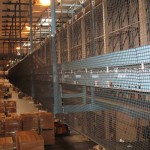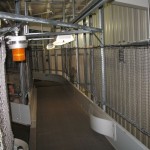Conveyor Belts: Netting Systems and Solutions
 You might not think overhead conveyor belts would be a safety hazard. After all, a conveyor belt itself is not a work environment. Workers don’t stand on the conveyor while working, and don’t normally climb up to it unless it needs repair or maintenance. Even then, the apparatus is fully shut down as they service it, and no safety-conscious worker would ever service a system while it was still running.
You might not think overhead conveyor belts would be a safety hazard. After all, a conveyor belt itself is not a work environment. Workers don’t stand on the conveyor while working, and don’t normally climb up to it unless it needs repair or maintenance. Even then, the apparatus is fully shut down as they service it, and no safety-conscious worker would ever service a system while it was still running.
The chief safety hazard with overhead conveyor belts comes not from the danger of falling, but from the danger of falling objects. If products – boxes, cases, bottles, luggage, etc. – get backed up on an overhead conveyor, they can tip up and fall over the side, and may injure workers below.
There’s also the danger of “roller blowout.” If the gears, roller wheels, and other machine parts of the system get stuck or jammed, they can suddenly burst out, and these flying objects can injure workers who are standing nearby! Or if the belt itself comes loose, it can fall and injure a worker.
Who Needs Conveyor Belt Netting?
In general, the types of places that need safety or debris netting for overhead conveyors fall under the heading of “high-volume distribution centers.” These are industrial facilities that handle high volumes of distribution for nationwide retail chains, shipping companies, or manufacturers.
If it’s a drugstore/convenience store chain, for example, their distribution center packs boxes of over-the-counter drugs, cosmetics, hair care products, etc., and distributes them to stores across the country. If it’s a supermarket chain, their distribution center packs and ships cases of canned and bottled food products. If it’s a nationwide shipping company, their distribution center handles sorting and shipping of packages and envelopes.
 Other places might need this type of safety netting. For example, an airport baggage facility may have overhead transporters that carry luggage and other objects (i.e. golf bags, ski equipment). These types of work areas can benefit from having safety netting installed under conveyor belts to catch falling objects.
Other places might need this type of safety netting. For example, an airport baggage facility may have overhead transporters that carry luggage and other objects (i.e. golf bags, ski equipment). These types of work areas can benefit from having safety netting installed under conveyor belts to catch falling objects.
Custom Netting Systems and Solutions for Conveyor Belts
One of the best types of safety netting to install for protection underneath conveyor belts is Raschel knotless, high-tenacity polypropylene netting. This heavy duty, industrial netting comes in several forms, with 1-inch, 1 3/4-inch, or 2-inch mesh.
There are factors to consider when installing the system, such as how many square feet of material is required to cover the area beneath the conveyor belt, so that falling objects don’t slip past the nets. You also have to consider the weight of objects on the conveyor belt, and the distance they will fall. If heavier objects (i.e. large, heavy boxes or suitcases) may fall from the conveyor belt, you should install stronger netting. If lighter objects (i.e. shampoo or cola bottles) may fall, you should use lighter netting.
If it’s possible that extra-small objects (i.e. roller parts) may fall or fly through the openings, you should install a debris liner for extra protection. A debris liner, like a window screen, is an ultra-fine mesh that will catch tiny objects and prevent them from falling through the regular netting.
Sometimes there are logistics problems when installing custom safety netting. A conveyor belt may be attached to a high ceiling, or located next to a wall, or in a back corner where it’s difficult to install material around or beneath it. Some distribution centers are so tightly packed with conveyor belts that it’s hard to find space between them to install the material. Or there may be machinery or other large objects under a conveyor belt, which makes it hard to position a manlift underneath it to install the system.
One common logistics problem is when to install the safety netting solution. Since many distribution facilities are operating 24/7, you often have to do the installation in the overnight hours, when there aren’t as many workers around. During this time period, you can usually shut down a line for a few hours for installation without seriously disrupting the facility’s productivity.
Once it’s installed, the safety netting is an important safeguard for that work area. It helps ensure worker safety and continued productivity at that facility through the absence of worker injuries.

